
МИНИСТЕРСТВО ОБРАЗОВАНИЯ КРАСНОЯРСКОГО КРАЯ
краевое государственное бюджетное профессиональное образовательное учреждение
«Красноярский технологический техникум пищевой промышленности»
РАБОЧАЯ ТЕТРАДЬ
по дисциплине «Иностранный язык в профессиональной деятельности»
для профессии 43.01.09 «Повар, кондитер»
специальности 43.02.15 «Поварское и кондитерское дело»
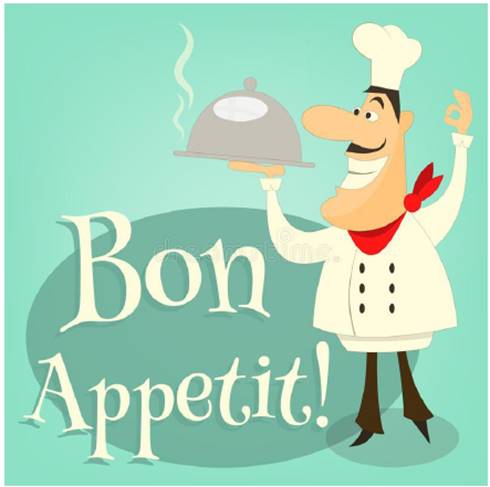
Разработала: преподаватель
иностранного языка
Пономарева Римма Анатольевна
Петрушкина Алена Олеговна
Красноярск, 2023
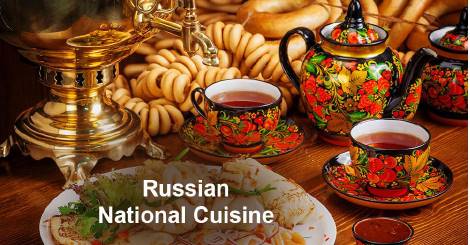
Russia is a huge country and that is why Russian cuisine is a rich collection of diverse cooking traditions. Russian food has its own peculiarities due to the country’s severe climate in winter and its forests rich in berries, mushrooms in summer. Traditional Russian dishes are often made of vegetables, different crops, dairy products, fresh-water fish, poultry and meat.
For breakfast Russian people usually have milk porridge, syrniki (cottage cheese pancakes) or an omelette. Lunch is more sufficient and it often consists of a salad, a plate of soup and a main course. For dinner the Russians love fish and meat dishes with garnish (rice, buckwheat, mashed potatoes and stewed cabbage).
Traditional pelmeni (meat dumplings), holodetz or Aspic (meat jelly with pieces of meat, carrot and garlic) or golubtsy (cabbage rolls with minced meat) are special masterpieces of the national culinary art. The Russians also have salads, meat pies, apple pies, vareniki (cottage cheese, cherries or potatoes dumplings) and pancakes for dinner.
The most traditional Russian salads are Olivier, “Herring under a fur coat” and vinegret. All of them are a nourishing mixture of various ingredients such as boiled eggs, boiled vegetables (potatoes, carrots, beetroot), sausage or meat, onions, green peas and cucumbers.
Russian cuisine is famous for the variety of soups: shchi (cabbage soup), borsch (red beetroot soup), ukha (fish soup), solyanka (thick soup made of pickled veggies, meat and sausage) and rassolnik (pickle soup). A plate of hot and spicy soup helps to stay warm during long cold winters. And one of the favourite soups
during hot summers is okroshka (cold vegetable and sausage soup based on kvas).
All kinds of soups are normally dressed with sour-cream. It is notable that Russian people eat bread with all dishes.
Traditional Russian drinks are hot black tea with jam or honey, compote (stewed fruit drink) and kvas (drink made from rye bre ad).The Russians are good at preserving fruits, vegetables and mushrooms. Classic Russian appetizers: pickled cabbage, tomatoes, crispy cucumbers and even apples – are always on a festive table.
Russian people have always been known for their hospitality. They are happy to welcome guests with lavish dinners with abundance of food on the table.
Exercise 1. Read the text about Russian cuisine and answer the questions below.
1. What are traditional Russian dishes often made of?
2. What do the Russians usually eat for breakfast?
3. What are the most famous salads in Russia?
4. What are soups normally dressed with?
5. Are the Russians hospitable?
Exercise 2. Look at the national Russian dishes and answer the questions below.
1. Do you consider Russian cuisine healthy?
2. Have you ever made any of these dishes?
3. What dishes do you like and why?
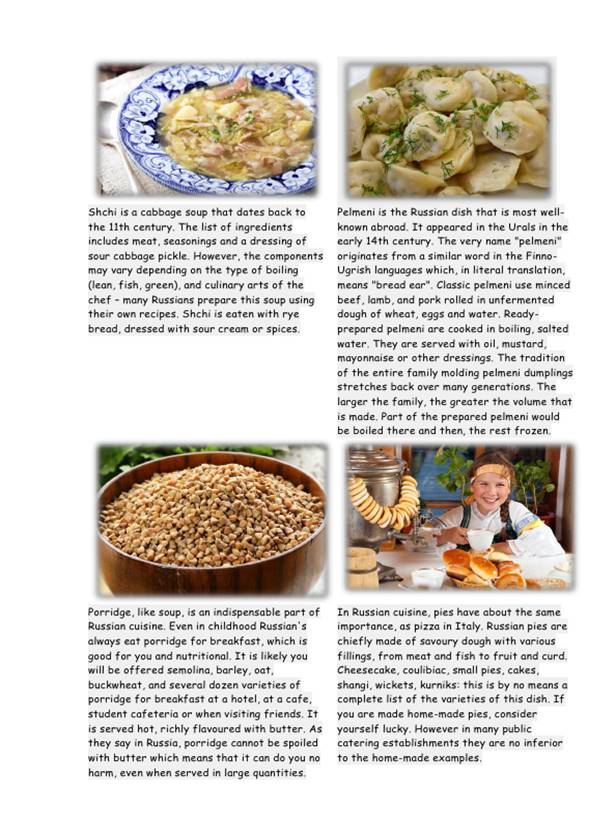
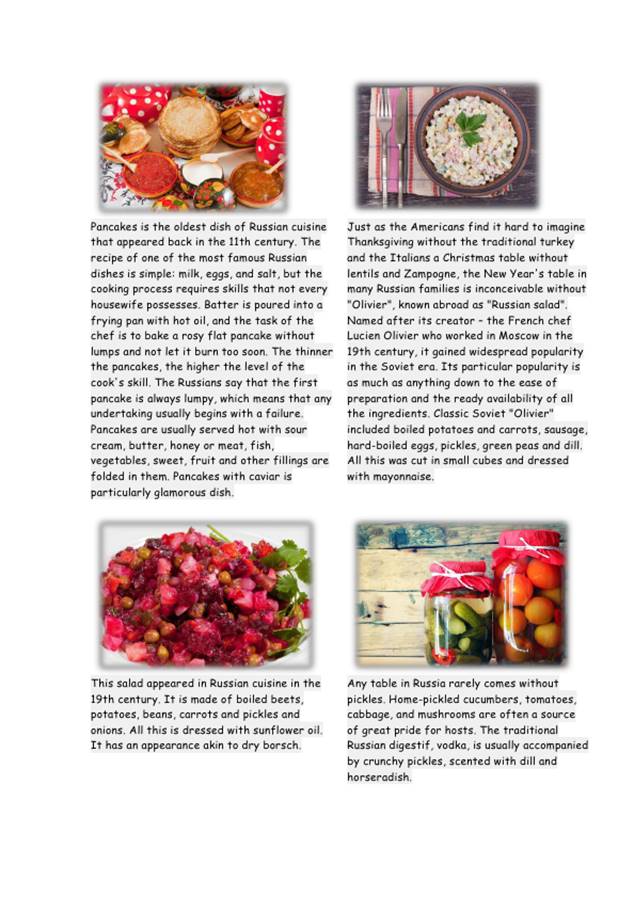
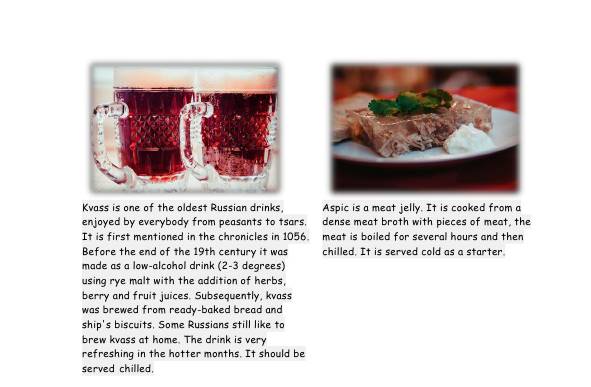
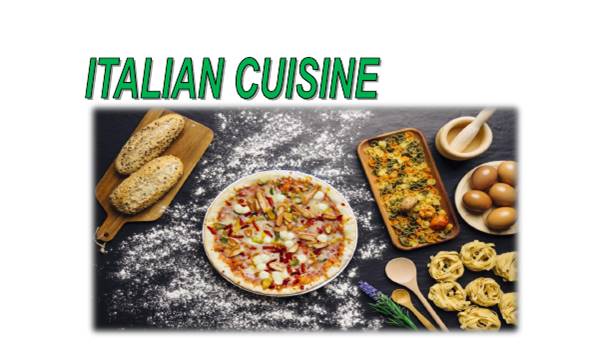
Exercise 1. Read the text about Italian cuisine. Tell us what distinctive features are inherent in Italian cuisine.
USUAL FOODS OF ITALIANS
Although Italians are known throughout the world for pizza, pasta, and tomato sauce, the national diet of Italy has traditionally differed greatly by region. Prior to the blending of cooking practices among different regions, it was possible to distinguish Italian cooking simply by the type of cooking fat used: butter was used in the north, pork fat in the center of the country, and olive oil in the south. Staple dishes in the north were rice and polenta, and pasta was most popular throughout the south. During the last decades of the twentieth century (1980s and 1990s), however, pasta and pizza (another traditional southern food) became popular in the north of Italy. Pasta is more likely to be served with a white cheese sauce in the north and a tomato-based sauce in the south.
Italians are known for their use of herbs in cooking, especially oregano, basil, thyme, parsley, rosemary, and sage. Cheese also plays an important role in Italian cuisine. There are more than 400 types of cheese made in Italy, with Parmesan, mozzarella, and as ago among the best known worldwide. Prosciutto ham, the most popular ingredient of the Italian antipasto (first course) was first made in Parma, a city that also gave its name to Parmesan cheese. To protect his produce from too much handling, this vendor displays a sign reading "Please don't touch" in Italian. Per favore is "please."
Exercise 2. Read and translate Italian recipes.
Pasta e Fagioli (Noodle and Bean Soup)

Ingredients
5 cups water
1½ cups dried white beans: navy, baby lima, or northern
1 onion, coarsely chopped
2 cups canned Italian-style tomatoes, with juice
1 cup each of celery and carrots, finely chopped and sliced
3 cloves garlic, coarsely chopped, or 1 teaspoon garlic granules
½ pound cooked smoked ham, chopped
3 bay leaves
½ cup macaroni (shells, bows, or elbows), uncooked
Salt and pepper, to taste
½ cup Parmesan cheese, grated, for garnish
Procedure
Place water and beans in saucepan.
Bring to a boil over high heat for 3 minutes and remove from heat.
Cover and set aside for 1 hour.
Add the onion, tomatoes, celery, carrots, garlic, smoked ham, and bay leaves.
Mix well and bring to a boil over high heat.
Reduce to simmer, cover, and cook until beans are tender (about 1½ hours).
Stir frequently.
Add macaroni and mix well. Cover and continue simmering until macaroni is tender (about 12 minutes).
Remove and throw out bay leaves before serving.
Serve hot soup in individual bowls with a side dish of Parmesan cheese for the guests to sprinkle into their soup. Serve with crusty bread to dip in the soup.
Serves about 6.
Fettucine Alfredo

Ingredients
1 cup butter or margarine at room temperature
½ cup heavy cream
½ cup Parmesan cheese, grated
1 pound cooked pasta, such as fettuccini (cook according to directions on package)
Salt, pepper, and ground nutmeg to taste
Procedure
Cook pasta according to directions on package. Warm a serving bowl in the
oven set to the lowest temperature until ready to use.
Place butter or margarine in a mixing bowl, and using a wooden spoon, beat until light and fluffy. Gradually add cream and mix until well blended.
Add the cheese by Tablespoon, beating well after each addition.
Using oven mitts, remove the heated serving bowl from oven and place on a heatproof work surface.
Place the drained, cooked pasta in the warm bowl and add cheese mixture.
Make sure all the pasta is coated with the sauce.
Add salt, pepper, and nutmeg to taste and continue to coat pasta.
Serve while very hot with a side dish of grated cheese.
The dish goes well with a green salad with Italian dressing and warm garlic bread.
Polenta

Commercial instant polenta is available in packages in the supermarket, usually displayed near the packaged rice. It would be an adequate substitute for the traditional method of preparation.
Ingredients
1 pound coarsely ground corn meal
8 cups water
1 teaspoon salt
Procedure
Measure the water into a large pot, add the salt, and heat the water to boiling.
Add the corn meal to the boiling water in a very slow stream, stirring constantly with a wooden spoon to keep lumps from forming.
Don't let the water stop boiling.
Continue stirring as the polenta (mush) thickens, for about 30 minutes, adding small amounts of boiling water if necessary (the longer you stir, the better the polenta will be; the finished polenta should have the consistency of firm mashed potatoes).
The polenta is done when it peels easily off the sides of the pot.
Saltimbocca alla Romana (Veal Scallops with Sage and Prosciutto)

Note: This recipe involves hot oil. Adult supervision is suggested.
Ingredients
12 slices of veal scallops (1½ pounds)
12 fresh sage leaves
12 slices of prosciutto ham
Flour, for dusting
3 Tablespoons unsalted butter
3 Tablespoons olive oil
1 cup white wine
1½ pounds freshly cooked spinach, seasoned with salt and pepper
Procedure
Spread out veal scallops and lay one sage leaf and one slice of ham on each.
Roll up and secure with toothpicks.
Lightly dust each with flour.
Heat the butter and oil in a skillet large enough to hold all the rolls in one layer.
Sauté, turning the rolls carefully, until brown.
Lift the veal from the pan and set aside on a warm platter.
Add the wine to the skillet, add salt and pepper to taste, and cook to reduce the size by half.
Arrange the hot spinach on a warm dish, place the veal on it, and cover with the wine sauce.

Exercise 1. Read the text about French restaurants.
French restaurants and eateries will soon have to put a new logo on menus to inform customers whether or not their food is home-made. France's government has come up with a simple sign so that both French people and tourists will have a better idea of what they are eating. Restaurants could start using the sign from July the 15th and it will be compulsory for eateries from January. The move comes after complaints about the quality of food being served in French restaurants. Many customers expect top-quality food when dining in France. The country is, after all, supposed to be the home of fine dining and gastronomic delights. French cuisine is world famous for its rich history, taste and presentation.
The new symbol is an attempt by the French government to improve the quality of restaurant food and boost tourism. A spokesperson said: "French gastronomy represents 13.5 per cent of foreign tourists' expenses. It is undeniable that if we add value to the quality of our restaurants, it will have an impact on tourism." He added that the government wants to, "reign in the amount of processed foods used and preserve France's high gastronomical standing". A poll conducted last year found that only around half of restaurant meals were cooked from scratch on the premises. The French Union of Hotel Skills and Industries believe that around 85 per cent of restaurants secretly use frozen or vacuum-packed food.
Exercise 2. Answer the questions.
COMPREHENSION QUESTIONS
1. What will new menus tell customers about?
2. When were restaurants first able to use the logo?
3. When will eateries have to put the logo on their menus?
4. What do many diners expect when eating at French restaurants?
5. What else is French food famous for besides a rich history and taste?
6. What does the French government hope to boost?
7. What proportion of their budget do tourists spend on eating out?
8. What does the French government want to reduce?
9. According to a poll, what proportion of food is cooked on the premises?
10. What is the percentage of restaurants that supposedly use frozen food?
Exercise 3. Role play. Take part in the discussion of nutrition, according to the chosen role.
ROLE PLAY
|
Role A – Mum's cooking
You think mum's cooking is the best food. Tell the others three reasons why. Tell what's wrong with their kind of food. Also, tell the others which is the least tasty of these (and why): fast food, street food or microwave meals. |
|
Role B – Fast food
You think fast food is the best food. Tell the others three reasons why. Tell what's wrong with their kind of food. Also, tell the others which is the least tasty of these (and why): mum's cooking, street food or microwave meals. |
|
Role C – Street food
You think street food is the best food. Tell the others three reasons why. Tell what's wrong with their kind of food. Also, tell the others which is the least tasty of these (and why): fast food, mum's cooking or microwave meals |
|
Role D – Microwave meals
You think microwave food is the best food. Tell the others three reasons why. Tell what's wrong with their kind of food. Also, tell the others which is the least tasty of these (and why): fast food, street food or mum's cooking |
Exercise 4. Read and translate French recipes.
Onion Soup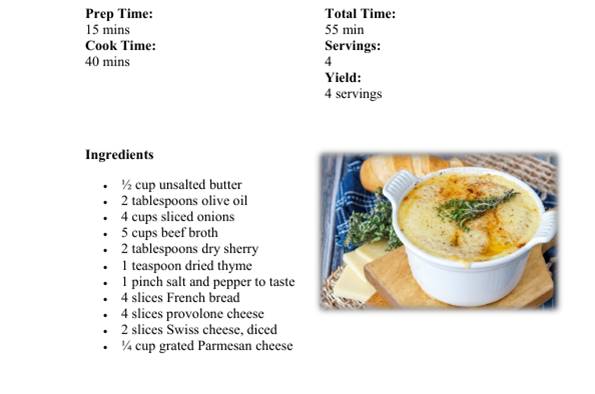
Directions
1. Melt butter with olive oil in an 8-quart stock pot over medium heat. Add onions and continually stir until tender and translucent. Do not brown the onions.
2. Add beef broth, sherry, and thyme. Season with salt and pepper. Let simmer for 30 minutes.
3. Meanwhile, preheat the oven's broiler.
4. Ladle soup into oven-safe serving bowls and place one slice of bread on top of each (bread may be broken into pieces if you prefer). Layer each slice of bread with a slice of provolone, 1/2 slice diced Swiss and 1 tablespoon
Parmesan cheese.
5. Place bowls on a cookie sheet and broil in the preheated oven until cheese bubbles and browns slightly, 2 to 3 minutes.
Herbs de Provence
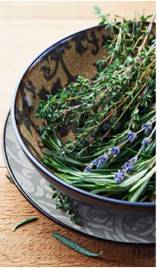
Ingredients
2 tablespoons dried rosemary
1 tablespoon fennel seed
2 tablespoons dried savory
2 tablespoons dried thyme
2 tablespoons dried basil
2 tablespoons dried marjoram
2 tablespoons dried lavender flowers
2 tablespoons dried Italian parsley
1 tablespoon dried oregano
1 tablespoon dried tarragon
1 teaspoon bay powder
Directions
1. Grind rosemary and fennel seed in a spice grinder; transfer to a mixing bowl.
2. Add savory, thyme, basil, marjoram, lavender, parsley, oregano, tarragon, and bay powder to the bowl; stir well. Store in an airtight container between uses.
Disney's Ratatouille
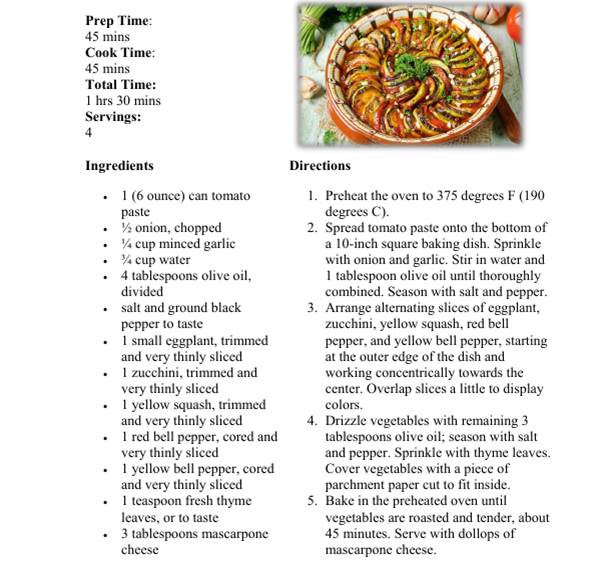
French
Macaroons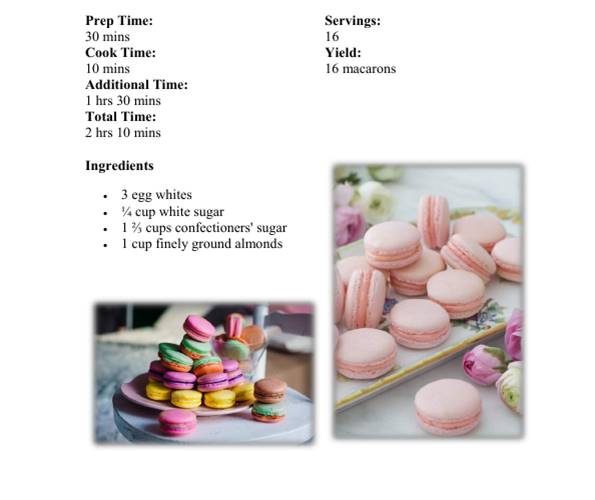
Directions
1. Line a baking sheet with a silicone baking mat.
2. Beat egg whites in the bowl of a stand mixer fitted with a whisk attachment until foamy. Add white sugar and beat until egg whites are glossy, fluffy, and hold soft peaks.
3. Sift confectioners' sugar and ground almonds in a separate bowl; quickly fold almond mixture into egg whites, about 30 strokes.
4. Spoon a small amount of batter into a plastic bag with a small corner cut off and pipe a test disk of batter, about 1 1/2 inches in diameter, onto the prepared baking sheet. If the disk of batter holds a peak instead of flattening immediately, gently fold batter a few more times and retest.
5. When batter is mixed enough to flatten immediately into an even disk, spoon into a pastry bag fitted with a plain round tip. Pipe batter onto the baking sheet in rounds, leaving space between the disks. Let piped cookies stand out at room temperature until they form a hard skin on top, about 1 hour.
6. Preheat the oven to 285 degrees F (140 degrees C).
7. Bake cookies in preheated oven until set but not browned, about 10 minutes.
8. Let cookies cool completely before filling, about 30 minutes.
Cook's Notes:
To measure by weight, use these amounts: 100g egg whites, 50g white sugar, 200g confectioners' sugar, and 110g ground almonds.
If you do not have a sifter, you can use a blender or food processor to thoroughly mix the almonds and confectioners' sugar. Just blend or pulse for 30 seconds.
Remember that because the consistency of the mix is like cake batter, you're going to have to be quick piping it onto the silicone mat. Hold the pastry bag sideways between piping so it doesn't spill.
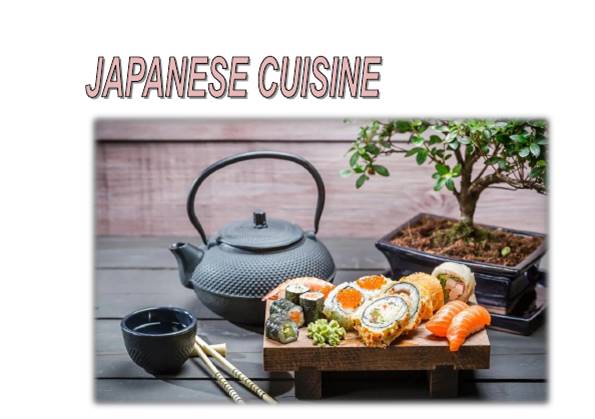
Exercise 1. Read the text and answer the questions.
FOODS OF THE JAPANESE
Japan accounts for about 8 percent of all the fish caught in the world. Each person in Japan eats more than 150 pounds of fish per year, or around three pounds of fish per week.
Rice and noodles are the two primary staples of the Japanese diet. Rice, either boiled or steamed, is served at every meal. Noodles come in many varieties.
Among the most popular are:
Ramen - thin, curly noodles, also made from wheat flour (egg noodles with soup, vegetables and meat or fish)
 Udon - thick white
noodles made from wheat flour . (Thick noodles with soup that can be with
tofu, meat or vegetables. For the hot dish, noodles and soup are usually
served together in the same bowl. For the cold dish, noodles and
soup are usually served in different dishes)
Udon - thick white
noodles made from wheat flour . (Thick noodles with soup that can be with
tofu, meat or vegetables. For the hot dish, noodles and soup are usually
served together in the same bowl. For the cold dish, noodles and
soup are usually served in different dishes)
 Soba - thin brown
noodles made from buckwheat flour. (Thin noodles with
soy-sausebased soup. In hot dishes, noodles and soup are usually
served together in the same bowl. For cold dishes, the noodles and
soup are usually served in different bowls). Noodles (like in most Asian foods)
are used often in Japanese foods. The dishes usually come originally from
China; nevertheless they have reached a unique development in Japan.
Soba - thin brown
noodles made from buckwheat flour. (Thin noodles with
soy-sausebased soup. In hot dishes, noodles and soup are usually
served together in the same bowl. For cold dishes, the noodles and
soup are usually served in different bowls). Noodles (like in most Asian foods)
are used often in Japanese foods. The dishes usually come originally from
China; nevertheless they have reached a unique development in Japan.
Soy sauce and other soybean products are also staples in Japan. These include miso (fermented soybean paste) and tofu (a soybean curd that resembles custard).
Soya beans are a very important ingredient in Japanese cooking; it is used in soya sauce, miso and tofu. Soya milk is also used as a drink. One example of a dish with soya beans in it, is tofu. Tofu is made from pressing soybeans into cubes and then boiling them. Tofu is often in soups and stews. Deep fried tofu is also used in many popular Japanese dishes, for example as kitsune udon and inari sushi. Soya beans also have omega 3 fatty acids that can also be found in salmon.
Other common ingredients in Japanese food include bamboo shoots, daikon (a giant white radish), ginger, seaweed, and sesame seed products. Japanese pickles called tsukemono are served at every meal. Seafood is also plentiful in this island nation. Green tea is the national beverage of Japan, although black tea is also available. Sake (SAH-kee, wine made from rice, usually served warm) and beer are also very popular.
Two uniquely Japanese foods are sushi (fresh raw seafood with rice) and sashimi (fresh raw seafood with soy sauce); both rely on freshly caught fish or seafood. Dishes prepared in a single pot (nabemeno ) are popular throughout Japan.

|
|
Wasabi is a spice traditionally prepared from a plant from the cabbage family. Its root is used as a spice and has a very strong flavor. The root is smashed up into paste and used as a condiment. Its hotness is more like hot mustard or horseradish than chili pepper, because it irritates the nose more than the tongue. Eating too much wasabi can cause a very painful feeling in the nose. It is often eaten with sushi.
|
|
Sukiyaki is a dish made up of paper-thin slices of beef (or sometimes chicken), vegetables, and cubes of tofu cooked in broth.
Shabu-shabu is beef and vegetables, also cooked in broth but then dipped in flavorful sauces.
Each region has its own selection of favorite foods. People living on the cold northern island of Hokkaido enjoy potatoes, corn, and barbecued meats.
Foods in western Japan tend to be more delicately flavored than those in the east. The Japanese are known for using very fresh ingredients in their cooking. They prefer using fresh, seasonal foods for their meals, buying it the same day it will be cooked. The Japanese are also famous for their skill in arranging food so that it looks beautiful. The people of Japan live long lives and have a low rate of heart disease because of healthy eating habits.
Questions for the text.
1. How much fish does each person in Japan eat per year?
2. What are the two primary staples of the Japanese diet?
3. What types of noodles are there?
4. What is made of soya beans?
5. What is tofu?
6. What other common ingredients are in Japanese food?
7. What are the national beverages of Japan?
8. What is sushi?
9. What is sashimi?
10. What is Wasabi?
11. What are others Japanese dishes?

Mexican cuisine has a rich history and must adapt the best traditions of African, Caribbean and South American cuisines to the hot mood of the Mexican people.
Temperament can be called a feature of Mexican cuisine: the dishes are different in spice. Another prominent feature is Mexican tabular etiquette. It prescribes to take dishes of national cuisine by hand. It is believed that all national dishes cannot do without the three traditional ingredients: corn cake, beans, chili peppers and tomato es.
Exercise 1. Read and translate Mexican recipes.
Burrito - a traditional dish of Mexican cuisine
|
|
For 5 servings you will need: 5 tortillas (cornmeal tortillas); 3 small chicken breasts; 2 tomatoes; fresh cucumber; Bell pepper; onion head; cheese; sauce (mayonnaise) and spices.
|
Chickens meat is boiled or cooked on the grill, then disassemble the fibers. Cutting into small pieces and roasting is allowed. Spices, which may include chili pepper, add at the stage of cooking meat. Onion, pepper, cucumber cut into medium-sized slices. We perform similar actions with tomatoes, but it is recommended to pre-remove the skin. Cheese, preferably hard grades, grind a coarse grater. The ingredients are mixed, priporivaya while spices and spices. Optionally, you can supplement the composition with hot pepper. Putting the filling in the tortilla, promazyvaya top sauce. Having formed a traditional “pocket”, we send it to the oven for 10 minutes.
Mexican Spicy Vegetables
|
For cooking spicy Mexican vegetable stew, you will need: pumpkin - 500 g; 2 carrots, onions, sweet peppers, potatoes, garlic cloves; tomatoes in their own juice - 400 g; beans - can of 400 g; hot peppers; water - 400 ml; vegetable oil - 30 ml; parsley - 10g
|
|
All vegetables, except garlic and hot pepper, cut into cubes of the same size. And the remaining garlic and pepper shred finely. In a skillet, warm the butter and fry the ingredients one by one (in the specified sequence): onions, carrots, sweet peppers, hot peppers, potatoes, and pumpkin. Fry 10 minutes and add the tomatoes in their own juice, garlic. Another couple of minutes - and pour water. Boil for a quarter of an hour and add salt, spices. Cook the composition on low heat for 10 -15 minutes and 5 minutes before switching off, add the beans.
Salsa
|
|
Salsa is one of the traditional sauces of Mexican cuisine. Ingredients: 500 g tomato; 2 chili peppers; 5 cloves of garlic; 100 g onions; 40 ml of lemon juice; 50 g cilantro; spices to taste.
|
Remove the skin from tomatoes and chop the pulp to a thick sauce. If you are too lazy to shred - we blend with a blender. Tomatoes take only ripe, most meaty. Onions and garlic finely shred and send to the tomatoes. It is time for lemon juice - send it in a bowl with tomatoes. If there is lime, then it is better to take it -the traditional recipe prescribes the addition of the juice of this particular fruit. Pepper is cleaned from seeds, cut and mixed with other ingredients, adding spices.
Материалы на данной страницы взяты из открытых источников либо размещены пользователем в соответствии с договором-офертой сайта. Вы можете сообщить о нарушении.